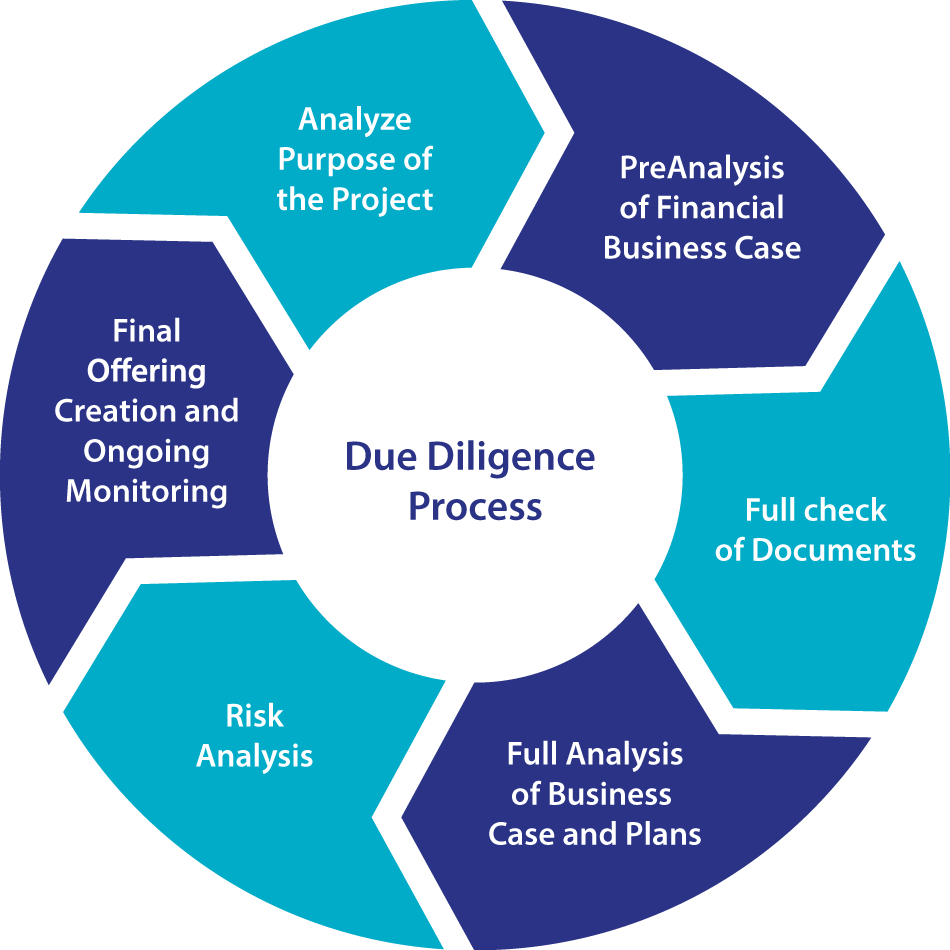Due Diligence
What are the Types of Due Diligence?
One of the most important and lengthy processes in an M&A deal is Due Diligence. The process of due diligence is something which the buyer conducts to confirm the accuracy of the seller’s claims. A potential M&A deal involves several types of due diligence.

Types of Due Diligence
Due diligence (DD) is an extensive process undertaken by an acquiring firm in order to thoroughly and completely assess the target company’s business, assets, capabilities, and financial performance. There may be as many as 20 or more angles of due diligence analysis.
The main types of due diligence inquiry are:
1. Administrative DD
Administrative DD is the aspect of due diligence that involves verifying admin-related items such as facilities, occupancy rate, number of workstations, etc. The idea of doing due diligence is to verify the various facilities owned or occupied by the seller and determine whether all operational costs are captured in the financials or not. Admin DD also gives a better picture of the kind of cost the buyer is likely to incur in case they plan to pursue expansion of the target company.
2. Financial DD
One of the most important types of due diligence is the financial due diligence that seeks to check whether the financials showcased in the Confidentiality Information Memorandum (CIM) are accurate or not. Financial DD aims to provide a thorough understanding of all the company’s financials, including, but not restricted to, audited financial statements for the last three years, recent un audited financial statements with comparable statements of the last year, the company’s projections and basis of such projections, capital expenditure plan, schedule of inventory, debtors and creditors, etc.
The financial due diligence process also involves analysis of major customer accounts, fixed and variable cost analysis, analysis of profit margins, and examination of internal control procedures. Financial DD additionally examines the company’s order book and sales pipeline, in order to create better (more accurate) projections.
Many acquirers have a separate section of financial analysis focused on the target company’s debt situation, evaluating both short-term and long-term debt, applicable interest rates, the company’s ability to service its outstanding debt and to secure more financing if needed, along with an overall examination and evaluation of the company’s capital structure.
3. Asset DD
Another of the types of due diligence conducted is asset DD. Asset due diligence reports typically include a detailed schedule of fixed assets and their locations (if possible physical verification should also be done), all lease agreements for equipment, a schedule of sales and purchases of major capital equipment during the last three to five years, real estate deeds, mortgages, title policies, and use permits.
4. Human Resources DD
Human resources due diligence is extensive. It may include all of the following:
- Analysis of total employees, including current positions, vacancies, due for retirement, and serving notice period
- Analysis of current salaries, bonuses paid during the last three years, and years of service
- All employment contracts with nondisclosure, non-solicitation, and non-competition agreements between the company and its employees. In case there are a few irregularities regarding the general contracts, any questions or issues need to be clarified.
- HR policies regarding annual leave, sick leave, and other forms of leave are reviewed.
- Analysis of employee problems, such as alleged wrongful termination, harassment, discrimination, and any legal cases pending with current or former employees
- Potential financial impact of any current labor disputes, requests for arbitration, or grievance procedures pending
- A list and description of all employee health benefits and welfare insurance policies or self-funded arrangements
- ESOPs and schedule of grants

5. Environmental DD
Diligence related to environmental regulation is very important because if the company violates any major rule, local authorities can exercise their right to penalize the company, up to and including shutting it down operationally. Hence, this makes environmental audits for each property owned or leased by the company one of the key types of due diligence. The following should be reviewed carefully:
- List of environmental permits and licenses and validation of the same
- Copies of all correspondence and notices with the EPA, and state or local regulatory agencies
- Verify that the company’s disposal methods are in sync with current regulations and guidelines
- Check to see whether there are any contingent environmental liabilities or continuing indemnification obligations.
6. Taxes DD
Due diligence in regard to tax liability includes a review of all taxes the company is required to pay and ensuring their proper calculation with no intention of under-reporting of taxes. Additionally, verify the status of any tax-related case pending with the tax authorities.
Documentation of tax compliance and potential issues typically includes verification and review of the following:
- Copies of all tax returns – including income tax, withholding, and sales tax – for the past three to five years
- Information relating to any past or pending tax audits of the company
- Documentation related to NOL (net operating loss) or any unused credit carry forwards of deductions or tax credits
- Any important, out-of-the-ordinary correspondence with tax agencies
7. Intellectual Property DD
Almost every company has intellectual property assets that they can use to monetize their business. These intangible assets are something that differentiates their product and service from their competitors, and may often comprise some of the company’s most valuable assets. A few of the items that need to be looked at in a due diligence review are:
- Schedule of patents and patent applications
- Schedule of copyrights, trademarks, and brand names
- Pending patents clearance documents
- Any pending claims case by or against the company in regard to violation of intellectual property
8. Legal DD
Legal due diligence is, of course, extremely important and typically includes examination and review of the following elements:
- Copy of Memorandum and Articles of Association
- Minutes of Board Meetings for the last three years
- Minutes of all meetings or actions of shareholders for the last three years
- Copy of share certificates issued to Key Management Personnel
- Copy of all guarantees to which the company is a party
- All material contracts, including any joint venture or partnership agreements; limited liability company or operating agreements
- Licensing or franchise agreements
- Copies of all loan agreements, bank financing agreements, and lines of credit to which company is a party
9. Customer DD
As customers or clients are the lifeblood of any business, the types of due diligence invariably include a close look at the target company’s customer base, with examination and analysis of the following:
- The company’s top customers: customers who make the largest total purchases from the company and also the customers who are the “largest” in terms of their total assets – customers that are important regardless of their current level of spending with the company
- Service agreements and corresponding insurance coverage
- Current credit policies; run and review the days sales outstanding metric (DSO) to assess the efficiency of accounts receivable
- Customer Satisfaction Score and related reports for past three years
- List, with explanations, of any major customers lost within the past three to five years
10. Strategic Fit
Acquirers are generally also very careful about exercising due diligence in regard to evaluating how well the target company fits in with the overall strategic business plan of the buyer. For example, a private equity firm considering a new acquisition will ask how well the proposed target will complement the firm’s existing portfolio of companies. A large corporation eyeing a possible M&A deal considers how easy (or how difficult) it is likely to be to successfully merge the target company into the buyer’s total corporate organization.
Following are some of the key strategic fit issues that acquirers look at and evaluate:
- Does the target have important technology, products, or market access that the acquirer lacks and has need of or can make profitable use of?
- Does the target have key personnel that represent a substantial gain in human resources?
- Assess operational and financial synergies benefits that can be expected from the target’s integration with the acquirer
- If the target company is to be merged with the acquirer or another firm the acquirer already owns, examine the plan for merging and project how long the merger process will take and estimate the cost of implementing the actual process of merging the two firms
- Determine the best personnel from both the acquirer and the target to manage the merger process
Other areas of due diligence research include IT networks, issues of stocks and/or bonds, research and development (R&D), and sales and marketing. Conducting thorough due diligence is critical to any successful acquisition. Without complete and intimate knowledge of the target company, it is impossible to make the best informed decisions on mergers and acquisitions.
In a proposed merger or a situation where shares of stock in the acquiring company constitute a major part of the purchase transaction, the target company may well look to perform its own due diligence on the acquirer.
Reference : CFI
7 comments:
LEGAL DUE DILIGENCE JOB JAKARTA
Great insights on the importance of due diligence in the textile industry! Conducting a thorough due diligence report is indeed crucial for minimizing risks and ensuring informed decision-making in business transactions. It’s interesting to see how this practice safeguards companies from potential financial and reputational losses. Thanks for sharing such valuable information!
We are the Top Business Due Diligence Services Provider, offering comprehensive risk assessments, financial analysis, and compliance checks to ensure informed decision-making. With expertise across industries, we help businesses mitigate risks, identify opportunities, and achieve seamless transactions. Trust us for accurate, reliable, and strategic due diligence solutions tailored to your needs.
Great insights on the importance of due diligence in the textile industry! A well-prepared due diligence report can mitigate risks and ensure informed decisions. For a detailed guide on creating one, check out this helpful resource: due diligence report. Keep up the informative posts!
This is a well-explained post on the critical role of due diligence in business decisions. It acts as a safeguard against surprises down the line and ensures transparency. I also appreciate the mention of different types, such as financial, legal, and operational due diligence. Equally important is integrating comprehensive tax due diligence services to uncover any hidden tax liabilities or compliance issues that could impact the transaction. Overall, due diligence, including tax aspects, is indispensable for building trust and securing successful business outcomes. Looking forward to more detailed insights on practical tools and techniques for effective due diligence!
This is a very informative post on Due Diligence Services. Conducting proper due diligence is essential for minimizing risks, uncovering hidden liabilities, and ensuring smart business decisions. A must for every serious investor!
Talreja Advisory & Consultancy Services is a trusted partner for comprehensive real estate and investment solutions. We specialize in Land Development Consultancy Services, REIT Investment Advisory Services (Real Estate Investment Trusts), Legal & Financial Support Services for Real Estate Projects, Architectural Planning Services for Real Estate Projects, and Equity/Mutual Funds Investment Services. With a client-focused approach and deep industry expertise, we provide strategic guidance, innovative solutions, and end-to-end support to help investors, developers, and businesses achieve sustainable growth and long-term success.
Post a Comment